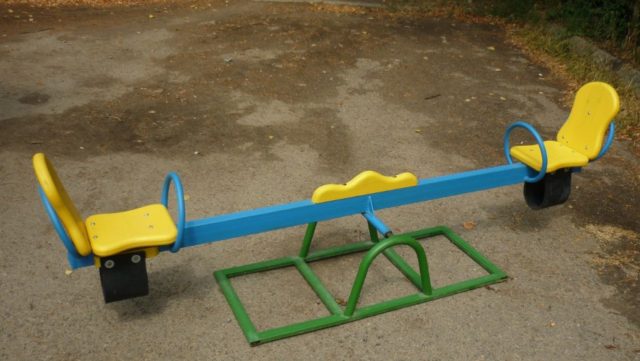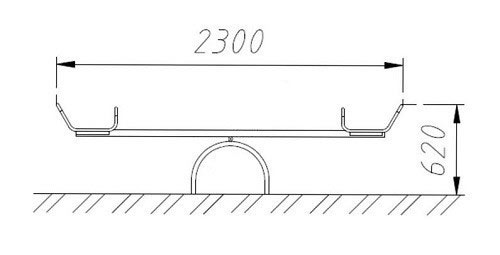Content
- 1 Operating principle of swing-balancer
- 2 Pros and cons of balancing swings
- 3 Types of children's outdoor swings-balance beam
- 4 What is needed to make a swing-balancer for the dacha
- 5 Dimensions of children's swing-balancer
- 6 Schemes of swing-balancer
- 7 How to make a swing-balancer with your own hands
- 8 Useful tips
- 9 Conclusion
Do-it-yourself swing-balancers are made from boards, logs, car wheels and other materials available on the farm. For the attraction, it is important to have a long lever, and any suitable object will act as a support, even the stump of a cut tree left in the clearing. To properly build scales, you need to know their operating features.
Operating principle of swing-balancer
To understand how a swing works, you need to look at its design. The basis of the balancer is the support. It can be permanently fixed by concreting or digging into the ground, or simply stand on the surface of the ground. A long lever with seats for people to sit is attached to the support.
Based on the description of the swing-balance, the operation of the attraction resembles a pendulum swinging from side to side. The device is made according to the principle of simple scales.The place of attachment to the support is the center of the lever. The resulting two opposite wings must have the same length and mass in order to maintain balance. When children sit on the lever seats, they begin to rise and fall alternately under their own weight. It is advisable that a child with approximately the same body weight sit on opposite seats of the lever, otherwise there will be an advantage in one direction.
The rolling of the balancers occurs by pushing off the ground with your feet. To ensure a soft landing, a shock absorber is installed on the back of the lever under the seats. The role of this unit is played by a piece of plastic or rubber pipe, a piece of a car tire, or a thick spring.
Pros and cons of balancing swings
The main advantage of balancers is the ability to adapt a child to society. The swing is intended for group riding only. You won’t be able to have fun alone, no matter how much you want. During pair skating, children find a common language and learn to communicate in a team.
2
Another advantage of swings is the development of children. Rolling on a balance beam requires physical effort. Children develop muscles in their legs, back and arms.
If we talk about the disadvantages of swings, then the unpaired number of children in a group sometimes causes a dispute over the order of skating. Alone, such an attraction is uninteresting and useless for a child. When children have significant differences in body weight, the balancer is difficult and sometimes even impossible to use. The disadvantage is the age restriction. Children who are too young cannot be put on swings. The balancer is not suitable for children with weak physical development.
Types of children's outdoor swings-balance beam
There are many types of balancers in terms of design. Craftsmen create designs with additional options with their own hands, but they all work according to the same principle of scales:
- A classic swing for a children's playground is a long log, beam or board with two seats at the edges. They are usually equipped with handles. The lever is mounted on a support, which is a concrete block, a dug-in post, a stump of a cut tree, or any other suitable object.
- A balancer on springs is considered a complicated design. A special feature of the swing is the design of the working mechanism. At the bottom of the lever, on both sides of the support, powerful compression springs are installed at equal distances. It takes less effort to control the balancer. It is important to keep your balance and push off slightly with your feet.
Advice! Balancers with springs are suitable for children under five years of age. - An attraction made from a tire is considered a mobile structure. The support of the balancer is half of the wheel, to which a board is attached on top. Children can carry the swing around the playground themselves.
- Rotary balancers have a special support device. It is made of metal and necessarily has a hinge rotating on a bearing. It is to this that the swing lever is attached. While having fun, children can not only swing, but also rotate on the balance beam around the axis of the support.
Important! Rotary balancers develop children's motor skills and improve coordination of movements. - Double balancers have one common support, but two parallel arms. Each of them is equipped with one seat on one side.Four children can have fun on the swing at the same time, but each pair is independent of each other.
- The paired balancers are made according to the principle of the classic swing design. The difference is the presence of two seats at each end of the lever. The swing can accommodate 4 people at a time. Since the seats are located on the same lever, both pairs of children ride at the same time. They cannot be independent of each other.
Every parent can make any of the pendulum swings considered for their child with their own hands.
What is needed to make a swing-balancer for the dacha
To make an attraction for children with their own hands, they use only two types of materials: wood and metal. If we consider in a general concept, then balancers can also be made of plastic or combined. Each design has its own positive and negative qualities:
- Wooden balancers are most often assembled by hand. The popularity of swings is explained by the availability of the material and ease of processing. The design is light and easy to control. Wood is a natural, environmentally friendly material that is safe for children. However, the wood quickly disappears if the swing is placed outdoors all year round. Painting and treatment with an antiseptic helps to extend the life of balancers.
- Metal is superior to wood in terms of strength and longevity. However, the material similarly needs to be painted to protect against corrosion. Making a balancer with your own hands is more difficult. You will need a welding machine and experience working with it. In addition, metal is more expensive than wood. The swing turns out to be heavy and more dangerous for children.
- Plastic balancers are lightweight, safe, and do not disappear in damp conditions.The disadvantage is the impossibility of making it yourself. Plastic swings are bought in a store. You only need to assemble the attraction with your own hands according to the included instructions.
Combined swings may contain all three types of materials. For example, you make your own metal support, a wooden lever, and plastic seats.
Dimensions of children's swing-balancer
For hanging swings, the size requirements are shown in GOST. State regulations do not apply to balancers. When making an attraction with your own hands, you individually determine what age it is designed for.
Approximate sizes are determined in the following ranges:
- The length of the lever depends on the height of the swing support. The larger it is, the longer the board is needed. If the lever is placed short on a high support, a large working stroke angle will be obtained. Children will be able to climb higher, but it will be more difficult to control the swing. Typically the length of the lever varies from 2 to 2.7 m.
- The height of the swing balancer depends on the support, and this parameter, as discussed above, is related to the length of the lever. However, you need to take into account the child's height. If the support is too high, it is difficult to climb onto the seat and push off the ground with your feet while rocking. A bearing that is too low reduces the stroke angle. It's not fun to ride on such a balance beam. On average, the height of the support varies from 0.5 to 0.8 m.
- It is equally important to equip yourself with comfortable seats on the lever. The following dimensions are optimal: width - 40 cm, length - 60 cm, while the height of the handles is 20 cm, and the height of the back is 30 cm.
It is optimal to calculate the dimensions so that when the balancer swings, the seats rise to a height of 50-60 cm from the ground.
Schemes of swing-balancer
How to make a swing-balancer with your own hands
Before production begins, you need to decide on the purpose of the attraction. In other words, you decided to assemble a swing balance for adults or children with your own hands. The choice of material depends on this so that its strength matches the load, as well as the dimensions of the structure.
The video shows an example of children's entertainment in the country:
How to make a wooden scale swing with your own hands
For children's attractions, wood is considered the best building material. The lever is created with your own hands from a long log of timber or board. Only a beam or log is suitable for support. The board can be used if its thickness is at least 50 mm. The principle of making balancers from any lumber is the same.
To support the swing, you need to install two posts parallel to each other with your own hands. The distance between them is equal to the width of the lever plus a small gap to ensure free rolling. If you make a stationary swing for children with your own hands, then the stands are dug or concreted in the ground. To build a portable attraction, stops are attached perpendicularly to the lower ends of the posts. Each stand becomes shaped like an inverted "T". The jibs connecting the stand to the stop prevent it from loosening.
In the upper part of the racks, drill coaxial holes with your own hands. A similar procedure is carried out with a lever. The hole is drilled strictly in the center of the workpiece to maintain balance. The lever is placed between two posts. A metal threaded rod is used to connect it to the support and secure it with nuts.The lever should swing freely with hand effort.
Now all that remains is to secure the seats from pieces of board, handles, and, if necessary, the backrests. Wooden balancers are sanded with sandpaper, treated with an antiseptic, painted or varnished.
How to make a metal swing with your own hands
For a metal attraction, the role of a lever is played by a pipe with a diameter of 50 mm. The choice of cross-section is increased if the swing is designed for adults. A good choice is profile. Due to the edges, a square pipe can withstand a large load.
The support for the stationary swing is a pipe concreted in the ground with a diameter of 75-100 mm. For a mobile balancer, from tubes and elbows with a diameter of 32-40 mm, you weld a cross-shaped support with your own hands and install it on the surface of the ground.
To fix the lever, the top of the support is equipped with a U-shaped bracket in an inverted state. Coaxial holes are drilled on the side shelves. In the center of the lever, it is optimal to weld a sleeve across the pipe, through which a pin is passed during fixation to the U-shaped bracket. Instead of welding the bushing, you can drill a hole in the center of the lever itself, but the pipe will weaken at this point. During heavy loads, it will bend here and may even break.
The seats on the lever are attached with your own hands from wooden boards. Ready-made plastic seats from children's bicycles are suitable. The handles are bent from a tube with a diameter of 15-20 mm. The finished swing is degreased, primed, and painted. A rubber hose is pulled over the handles to make it more comfortable for children to hold on to.
How to make a swing pendulum from tires with your own hands
Old car wheels are considered good material for balancers.Moreover, the swing can be made for pairs and, as an exception, singles.
A classic rocker swing is created with your own hands from half a tire and a board. The wheel acts as a support. The tire is cut in half. One part of it is fixed to the center of the lever using embedded bars with self-tapping screws. The second half of the tire is again sawn into two equal parts. Each of them is fixed with your own hands to the board under the bottom of the seat. The elements will play the role of shock absorbers. Each seat is equipped with handles, the board is sanded and painted along with the support. The version of balancers turns out to be mobile. The swing can be moved around the site or hidden in a barn for the winter.
Stationary classic balancers have support posts dug into the ground. Tires here only play the role of shock absorbers. The wheels are dug in vertically where the ends of the lever touch the ground. While riding, springing occurs from the tire.
The wheel is the only exception, allowing you to build a single balancer with your own hands. To make a gurney, it is enough to attach a piece of board to half of the tire, the length of which is equal to the diameter of the tire. On such an attraction, the child is able to have fun on his own.
The video shows a swing made from an old tire:
Useful tips
Balancers are considered an interesting entertainment, but for safe use you should listen to useful tips:
- It is optimal to allow children over 5 years of age to ride. At this age, their coordination is better developed. The likelihood of a child falling is reduced.
- Children under 5 years of age ride under parental supervision.
- There must be shock absorbers under the seat on the lever. The elements additionally act as limiters that prevent the legs from being pinched by pressing the lever to the ground.The shock absorber must create a clearance of at least 23 cm.
A few simple rules will ensure children have safe fun on the playground.
Conclusion
You can build a simple swing-balancer with your own hands in a few hours. If you choose a complex design with springs or a swing arm, you will have to allocate 1-2 days of free time.



























